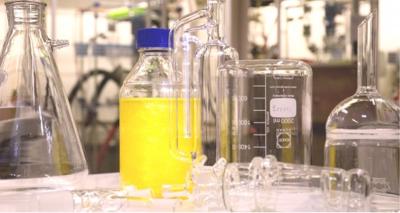In December 2018, Greatcell Solar declared bankruptcy, a sad ending to a once promising perovskite venture. However, prior to this bankruptcy (in September 2018), the Production Division of Greatcell Solar was sold off, in a new business called Greatcell Solar Materials (GSM).

GSM manufactures and supplies its products like perovskite precursors, silver inks, various dopants and more to the scientific community. The company's general manager, Dr. Yanek Hebting, kindly agreed to answer some of our questions regarding GSM's business and technology.
From 2006, the Materials Division of Dyesol Australia focused on the development and commercialization of Dyes, Metal Oxide Pastes and Conductive Pastes for the industrialization of DSC technology. More recently, and with the advent of PSC technology and reflected in the change of name of the company from Dyesol Australia to Greatcell Solar Australia, the materials relevant to the industrialization of perovskite-based PV were developed and subsequently commercialized.
As the Materials Division's commercial activities grew, so too did the imbalance between the business models of the Materials Division and Greatcell Solar Australia. Thus, to allow both enterprises to make the most of their resources and grow, it was decided to spin off the Materials Division through a management buyout to form the company Greatcell Solar Materials Pty Ltd (GSM).
Q. What is GSM's current status following the spin-off from GreatCell in 2018?
The separation of GSM from Greatcell Solar has allowed it to focus and concentrate on the commercialization and manufacture of materials for the PSC market whilst maintaining the DSC materials available. All materials previously offered by Greatcell Solar Australia are still offered by GSM; produced to the same stringent standards. Since spinning off, GSM has also increased its materials diversity; for example; new product offerings have increased in terms of both anions and cations available in our Perovskite Precursor range to enable researchers to investigate the effect of ion sizes and configuration in perovskite structures and to tailor their systems to various specifications.
Q. GSM is offering a wide range of solar materials. Can you elaborate on the perovskite materials on offer? What are the most popular ones, and which ones do you predict will be the most popular ones in the future?
GSM aims to be a one-stop shop for PSC researchers and industrialists. The characteristics of the offerings GSM is probably best known for is not singular but would be for its wide range of Perovskite Precursors available, of which Methylammonium iodide remains one of our most popular products. With the aim of optimizing performance and stability of PSC devices, GSM offers a wide range of ammonium halides (e.g. iodides, bromides and chlorides) and pseudo-halides (e.g. thiocyanates, tetrafluoroborates, hexafluorophosphates) designed to be used as replacement or dopant in existing composition to investigate and optimize various device parameters. Recently, GSM has developed a range of ammonium carboxylates (acetates and trifluoroacetates) for applications such as perovskites piezoelectrics, perovskites ferroelectrics and perovskites molecular switches. Predicting which product will become the most popular is difficult to answer. Nevertheless, GSM has observed an increase in diversity indicating people are trying new products.
Q. Perovskite solar panels are promising but not yet commercial. What in your opinion are the greatest challenges for our industry at the moment?
As with any solar technology it is performance, stability and cost. These challenges will be solved by a combination of materials and engineering. As a supplier of materials, GSM is and will be present to assist and support developers of devices with new materials, custom materials or formulations, and scale-up of existing materials. As always, this will be backed by GSM's reputation for high quality and consistency.
Q. When do you see perovskite solar panels on the market?
The advent of the PSC technology started around 2013 and escalated quite rapidly to high performing panels. The whole community has been taken by surprise by the speed of development. Given the development has already been ongoing for 5 years and performances are now in the low to mid 20s from results obtained in academic research laboratories, we think within the next 3-5 year a commercial product will be available in the market.
Q. What are GSM's plans for the next 5 years?
GSM expects to expand and will maintain its continuous development of innovative materials. GSM is ready to partner with any industry involved in the development and commercialization of the PSC technology.
GSM is also aiming at providing materials at scale for the commercialization of other technologies such as LEDs, perovskites piezoelectric and ferroelectric devices as well as molecular switches.
About Dr. Yanek Hebtling
Dr. Yanek Hebting is the CEO of Greatcell Solar Materials Pty Ltd. Prior to this, he served as Head of Production at Greatcell Solar Ltd (formerly known as Dyesol Limited) and served as its Manager of Materials Research and Development. Dr. Hebting joined Dyesol as a Research Scientist in 2006. After having successfully scaled up to multi-kilogram level the production of panchromatic Ruthenium complexes, fulfilling Dyesol's largest ever order of Ruthenium Dye for the Welsh based DSC manufacturer G24i, he was promoted to Project Leader in the Materials Group. He was successful in scaling up and expanding the chemical manufacturing capabilities of novel 3rd generation PV materials by developing and applying cost effective optimized synthesis procedures. In 2005, he was the recipient of the MIT-France Seed Fund and in 2006, he received the Best Paper of the Year Award for his PhD work from the Geochemical Society. He holds a Masters Honors in Organic and Supramolecular Chemistry and a PhD in Organic Chemistry from the Université Louis Pasteur in Strasbourg, France. He conducted his post-doctoral work at Massachusetts Institute of Technology, where he was a Research Fellow funded by the American Chemical Society (ACS PRF recipient 2004).